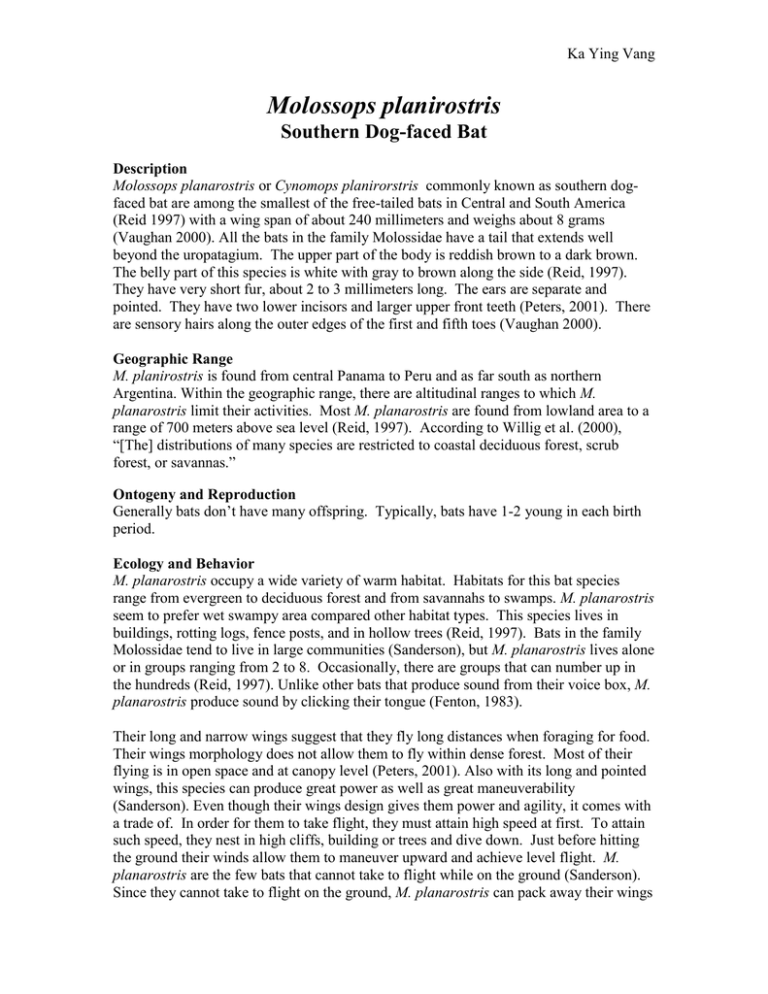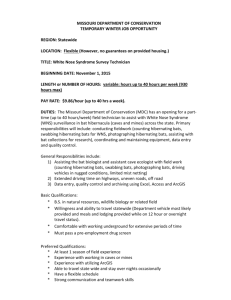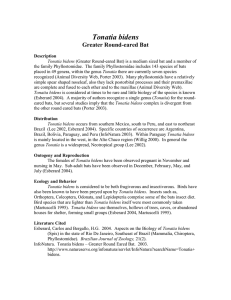Molossops planirostris Southern Dog-faced Bat
advertisement

Ka Ying Vang Molossops planirostris Southern Dog-faced Bat Description Molossops planarostris or Cynomops planirorstris commonly known as southern dogfaced bat are among the smallest of the free-tailed bats in Central and South America (Reid 1997) with a wing span of about 240 millimeters and weighs about 8 grams (Vaughan 2000). All the bats in the family Molossidae have a tail that extends well beyond the uropatagium. The upper part of the body is reddish brown to a dark brown. The belly part of this species is white with gray to brown along the side (Reid, 1997). They have very short fur, about 2 to 3 millimeters long. The ears are separate and pointed. They have two lower incisors and larger upper front teeth (Peters, 2001). There are sensory hairs along the outer edges of the first and fifth toes (Vaughan 2000). Geographic Range M. planirostris is found from central Panama to Peru and as far south as northern Argentina. Within the geographic range, there are altitudinal ranges to which M. planarostris limit their activities. Most M. planarostris are found from lowland area to a range of 700 meters above sea level (Reid, 1997). According to Willig et al. (2000), “[The] distributions of many species are restricted to coastal deciduous forest, scrub forest, or savannas.” Ontogeny and Reproduction Generally bats don’t have many offspring. Typically, bats have 1-2 young in each birth period. Ecology and Behavior M. planarostris occupy a wide variety of warm habitat. Habitats for this bat species range from evergreen to deciduous forest and from savannahs to swamps. M. planarostris seem to prefer wet swampy area compared other habitat types. This species lives in buildings, rotting logs, fence posts, and in hollow trees (Reid, 1997). Bats in the family Molossidae tend to live in large communities (Sanderson), but M. planarostris lives alone or in groups ranging from 2 to 8. Occasionally, there are groups that can number up in the hundreds (Reid, 1997). Unlike other bats that produce sound from their voice box, M. planarostris produce sound by clicking their tongue (Fenton, 1983). Their long and narrow wings suggest that they fly long distances when foraging for food. Their wings morphology does not allow them to fly within dense forest. Most of their flying is in open space and at canopy level (Peters, 2001). Also with its long and pointed wings, this species can produce great power as well as great maneuverability (Sanderson). Even though their wings design gives them power and agility, it comes with a trade of. In order for them to take flight, they must attain high speed at first. To attain such speed, they nest in high cliffs, building or trees and dive down. Just before hitting the ground their winds allow them to maneuver upward and achieve level flight. M. planarostris are the few bats that cannot take to flight while on the ground (Sanderson). Since they cannot take to flight on the ground, M. planarostris can pack away their wings and run about on all four limbs to escape from predator or to get to higher ground (Sanderson). Remarks Population Status: G5 – “Apparently secure- Uncommon but not rare; some cause for long-term concern due to decline or other factors” (Nature Server Org.). Literature Cited Fenton, M. Brock. Just Bats. Toronto, Buffalo, London. University of Toronto, 1983. InfoNature: Bird, mammal, and amphibians or Latin America. 2004. Version 3.2. Arlington, Virginia (USA): NatureServe. <http://www.natureserve.org/infonatura> Peters, Sandra L., Lim, Burton K., Engstrom, Mark D. “Systematics of Dog-Faced Bats (Cynomops) Based on Molecular and Morphometric Data.” Journal of Mammalogy 83 (2001): 1097-1110. Reid, Fiona A. A Field Guide to the Mammals of Central American & Southeast Mexico. Oxford. Oxford University Press. 1997. Sanderson, Ivan T. Living Mammals of the World. New York. Hanover House. Vaughan, Terry A., Ryan, James M., Czaplewski, Nicholas J. Mammalogy. New York. Saunders College Publishing. 2000. Willig, Michael R., et al. “Composition and Structure of Bat Assemblages in Paraguay: A Subtropical-Temperature Interface.” Journal of Mammalogy 81 (2000): 386-406. Reference written by Ka Ying Vang, Biology 378 (Mammalogy), University of Wisconsin – Stevens Point. Edited by Christopher Yahnke. Page last updated August 8, 2005.


